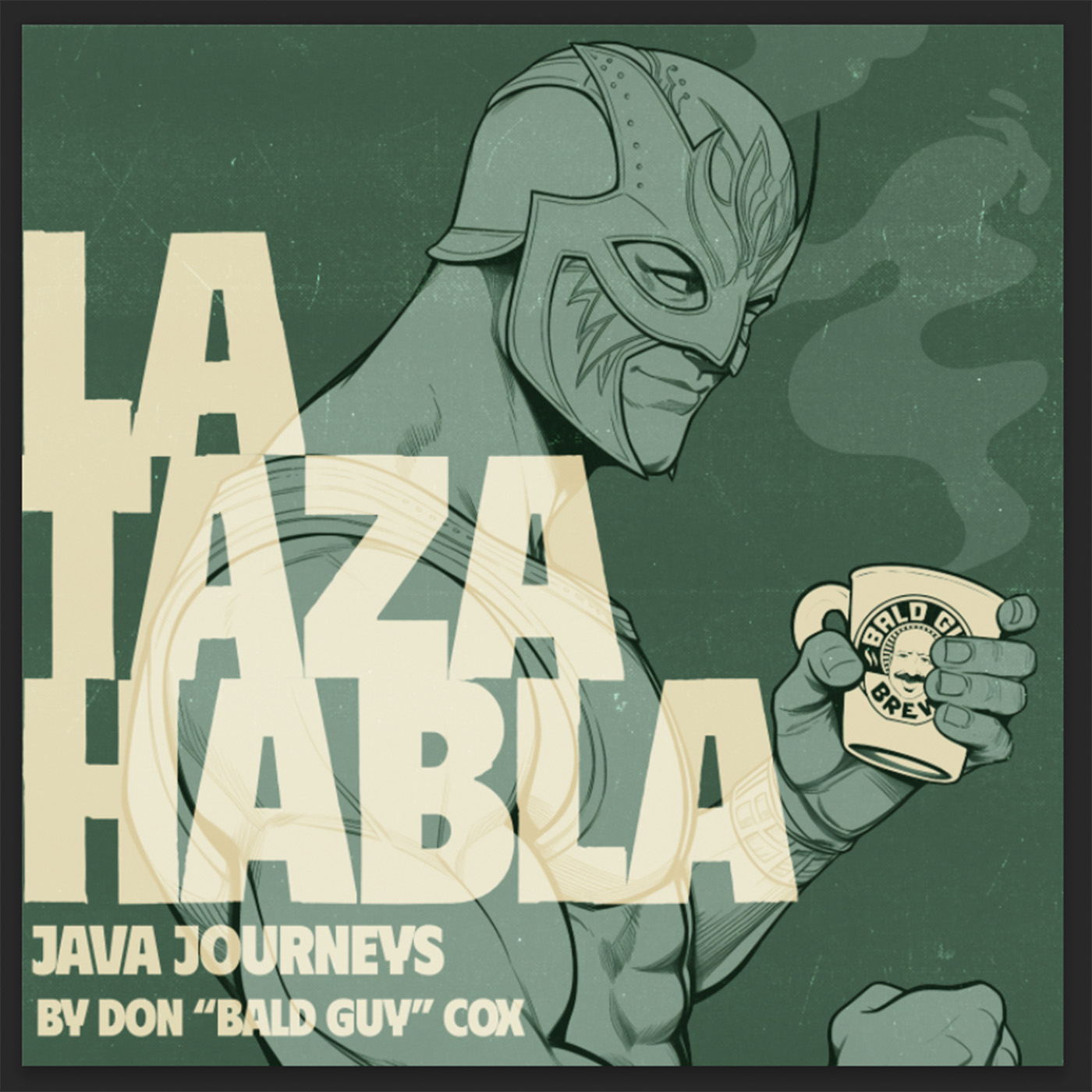
884
Downloads
13
Episodes
La Taza Habla (The Cup Talks) takes you on a 20-year java journey through specialty coffee’s rich tapestry, brought to you by ”Bald Guy Brew Coffee Roasting Co.”, nestled in the Blue Ridge Mountains of North Carolina. Each episode unveils the untold stories behind your daily brew—from origin to roast to ritual. Join founder and chief brain-hydrant Don Cox, a.k.a. ”Bald Guy,” as he transforms complex coffee concepts into engaging narratives that deepen your connection to what’s in your mug, the hands that crafted it, and why it matters. Visit us at www.baldguybrew.com or connect on Instagram and Facebook @baldguybrew.
Episodes

2 days ago
2 days ago
Step inside the roastery with Don Cox, "The Bald Guy," on this experimental episode of La Taza Habla, as he takes you on a sensory and scientific journey through the coffee roasting process. Discover the magical transformation of green coffee beans into the rich, aromatic brew you love. Don demystifies the complex interplay of conduction and convection heat transfer, tracing the historical evolution of roasting from open fires to modern drum roasters. Learn how the vital Maillard reaction creates depth of flavor and listen for the exhilarating sound of first crack, a pivotal moment in specialty coffee development. With 20 years of expertise, Don shares his unique approach to honoring the labor of coffee growers, emphasizing intuition and connection over rigid formulas. This episode isn't just about how coffee gets roasted; it's about what it feels like, a true "bean to cup" adventure for your ears and your mug. Tune in to deepen your appreciation for every sip.
- Share Your Story and Comments: Leave us a voice message using SpeakPipe
- Stay Connected: Get exclusive coffee stories & tips delivered to your inbox
- Fresh Roasted Coffee delivered to your door: Bald Guy Brew Coffee Roasting Co.
Guess the coffee that I roasted and it's on me. Just put your best guess in the comments and the first five individuals to get a bag of fresh roasted coffee! Here is a little help: go to the website and look over our list of coffees. I will tell you that it was not a decaf, espresso, Brazil, or Rwandan.
5 Takeaways
-
Roasting is a Blend of Art & Science: While scientific principles like conduction, convection, and chemical reactions (Maillard, endothermic, exothermic) are crucial, the roaster's intuition, sensory experience (smell, sight, sound), and human judgment are equally vital to achieving a great roast.
-
The Maillard Reaction is Key to Flavor: This complex chemical reaction, occurring when beans turn from yellow to light brown, is where the vast majority of coffee's desirable flavors and aromas are developed. Skipping or rushing this phase results in bland coffee.
-
"First Crack" is a Critical Milestone: This audible popping sound signifies a major exothermic reaction where vapor and gases burst through the bean's outer layer. It's a key indicator for roasters to gauge progress and sweetness development, guiding decisions on roast completion.
-
Heat Transfer Methods Matter: Early roasting involved direct conduction (metal to bean). Modern drum roasters combine conduction (drum heating beans) with convection (hot air enveloping beans) for more even and controlled roasting, enhancing overall flavor development.
-
Honoring the Bean is Paramount: The ultimate goal of a roaster isn't just to turn green beans brown, but to honor the hard work of those who grew the coffee, highlight its historical flavor profile, and ensure the quality in the cup reflects its origin.
3 Questions
-
What aspect of the coffee roasting process surprised you the most after listening to this episode?
-
Do you have a personal "sensory feedback" system you use for other foods or drinks? Share your experiences!
-
Before this episode, what did you imagine happened to coffee beans during roasting? How has your perspective changed?
Glossary
Conduction: The transfer of heat directly from one object to another. In coffee roasting, this refers to heat moving directly from the hot metal of the drum to the coffee beans. (e.g., sitting around a campfire; heat moves from metal to bean)
Convection: The transfer of heat through the movement of fluids (liquids or gases). In coffee roasting, this refers to hot air enveloping the coffee beans for even heating. (e.g., think a hairdryer; hot air now envelops the bean)
Cooling Tray: The mechanism in a roaster where roasted coffee beans are immediately dropped after the roast is complete to rapidly cool them and halt the roasting process.
Drum Roaster: A type of coffee roasting machine that uses a rotating drum to heat and tumble coffee beans, typically combining both conduction and convection heat transfer. (e.g., in the eighteen hundreds, you have drum roasters arriving in Europe)
Endothermic Reaction: A chemical reaction that absorbs heat from its surroundings. In coffee roasting, this phase occurs early on as heat is put into the green beans to prepare them for later transformations.
Exothermic Reaction: A chemical reaction that releases heat. In coffee roasting, this is prominently observed during "first crack," where the bean structure breaks down and releases energy, moisture, and gases.
First Crack: A critical stage in coffee roasting, characterized by an audible "cracking" sound (like popping popcorn or an old typewriter). It signifies an exothermic reaction where moisture and gases forcefully escape the bean, causing it to expand.
Green Beans: Unroasted coffee beans, in their raw state, before any heat has been applied.
Maillard Reaction: A complex chemical reaction between amino acids and reducing sugars that gives browned food its distinctive flavor. In coffee roasting, this crucial phase is where the bean develops depth, aroma, and complex flavors, transitioning from a pale yellow to light brown. (e.g., this phase that we're in is really where the magic happens)
Roaster's Choice Brown: A term used to describe the point at which a roaster decides to stop the roast, based on their sensory evaluation (smell, sight, taste, feel) rather than a fixed temperature or time, reflecting their expertise and desired flavor profile.
Trier: A small, specialized tool inserted into the face of the roasting drum. It allows the roaster to extract a small sample of beans during the roast to visually inspect their color, smell their aroma, and gauge their development. (e.g., my friend, my guide through this whole process as I'm roasting right now is the trier)
Vapor Wedge: Refers to the moisture inside the coffee bean turning to steam during roasting, which creates pressure that eventually "blows through" the cellular structures, leading to the audible "first crack."

No comments yet. Be the first to say something!